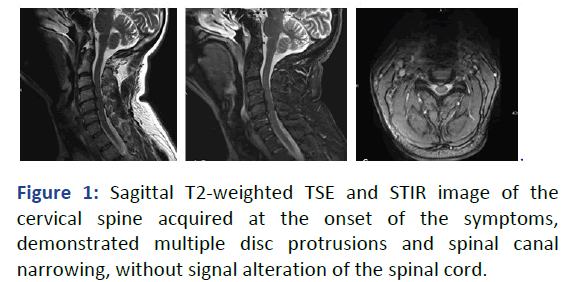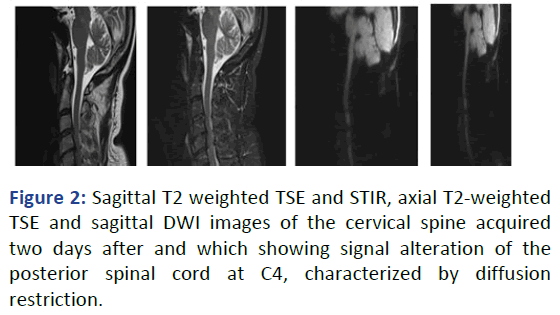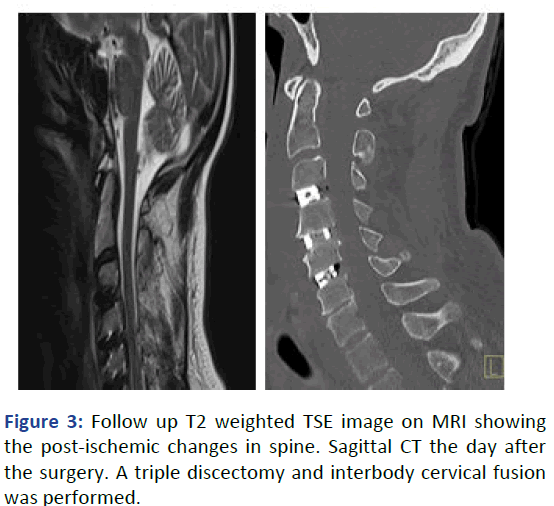Case Report - (2023) Volume 10, Issue 8
Acute Non Traumatic Cervical Mielopathy in an Adult Patient: A Challenging Diagnosis
Nuzzi Daniele1*,
Alvaro Lorenzo1,
Zambon Giampaolo1,
Varotto Alessia2 and
Bissoli Angela2
1Department of Neurosurgery, San Bortolo Hospital, Vicenza, Italy
2Department of Neuroradiology, San Bortolo Hospital, Vicenza, Italy
*Correspondence:
Nuzzi Daniele, Department of Neurosurgery, San Bortolo Hospital, Vicenza,
Italy,
Email:
Received: 12-May-2023, Manuscript No. IPBJR-23-16460;
Editor assigned: 17-May-2023, Pre QC No. IPBJR-23-16460 (PQ);
Reviewed: 31-May-2023, QC No. IPBJR-23-16460;
Revised: 19-Jul-2023, Manuscript No. IPBJR-23-16460 (R);
Published:
31-Aug-2023, DOI: 10.35841/2394-3718-10.8.71
Abstract
Introduction: Acute cervical myelopathy is a challenging diagnosis. Spinal cord infarction is generally
caused by aortic pathologies. In absence of a definite diagnosis, fibrocartilagineous embolism can be a
cause of spinal cord ischemia.
Case presentation: Authors here presented a case report of a 42 years old female patient, suffering
acute myelopathy in a stenotic cervical canal by anterior osteophytes.
She was admitted to our emergency department with chest pain and tetraparesis, manifesting with
two acute episodes within 24 hours of each other, the second worse than the first. Traumatic,
inflammatory, ischemic, infectious and compressive causes were excluded. Both neuroprotection
therapies (administration of glucocorticoids, maintenance of mean arterial pressure) and surgical
decompression of stenotic cervical canal were adopted. Follow-up was characterized by neurological
improvement.
Conclusion: To our knowledge, the case here reported is the first of a suspected FCE in a stenotic CC
surgically decompressed. FCE is generally an exclusive diagnosis; definite diagnosis could be only
provided by spinal cord biopsy examination. Cervical canal decompression, by removing anterior
osteophytes, probably contributed to SC adequate vascular perfusion through the anterior spinal
artery and prevented secondary damage from medullary swelling.
Keywords
Acute myelopaty; Narrow cervical canal; Spinal cord infarction; Fibrocartilagineous
embolism; Tethraparesis
Abbreviations
ASA: Anterior Spinal Artery; CC: Cervical Canal; CSF: Cerebrospinal Fluid; FCE:
Fibrocartilagineous Embolism; MRI: Magnetic Resonance Imaging; MS: Medullary Swelling; SC: Spinal
Cord; SCI: Spinal Cord Ischemia; SCPP: Spinal Cord Perfusion Pressure; TSE: Turbo Spin Echo; STIR:
Short Tau Inversion Recovery; GRE: Gradient Echo; DWI: Diffusion Weighted Imaging
Introduction
SCI is a very rare clinical occurrence and causes important
permanent neurological disabilities. Despite clinical efforts in
prevention and treatment, clinical outcome is disabling.
Therapy is based on neuroprotection principles. As well as in
medullary contusion, cervical canal decompression surgery
can play an important role [1]. We wanted to apply these
principles to a suspected case of FCE in a 42-year-old female
patient suffering from a severe acute form of myelopathy.
Case Presentation
A 42-year-old patient was admitted to emergency department
for generalized malaise, chest attack pain and numb limbs.
Symptoms began acutely without physical exertion and
trauma [2]. An aortic angio-CT scan did not document
vascular lesions, in particular no dissecting lesions were
documented. Brain and cervical spine CT scans, as well as
cerebral angio-CT study, were performed but they did not
reveal any disease. In the event of a cardiovascular problem,
antiplatelet precautionary therapy was set up. Cervical spine
MRI scan documented a stenotic canal, in particular C3-C4 C4-
C5 C5-C6 anterior osteophytes, and no evidence of
myelopathy (Figure 1). Patient was admitted to neurological
operative unit and 12 hours later onset, presented a complete
restoration to complete of the beginning symptoms (ASIA E).
Rachicentesis was performed with CSF examination, in order
to exclude inflammatory spinal cord injury; the only alteration
was a mild protidorrachia [3]. Infectious and oligoclonal bands
CSF laboratory tests were negative.

Figure 1: Sagittal T2-weighted TSE and STIR image of the
cervical spine acquired at the onset of the symptoms,
demonstrated multiple disc protrusions and spinal canal
narrowing, without signal alteration of the spinal cord.
Both medical history and following examinations documented
absence of autoimmune, vasculitis and infectious diseases. 24
hours later clinical onset, patient began to present a further
clinical worsening with tetraparesis: Severe upper limbs
diparesis in the distal segments, right lower limb plegia, pain
in the four limbs, urinary retention (ASIA C). Sudden and
persistent chest pain also appeared. A cervical spine MRI scan
documented radiological modification: Intra-medullary
alteration signal of the posterior C4 cords evident in the
sequences in T2 suggesting ischemia (Figure 2). Moreover, MS
was already present [4]. Patient underwent anterior cervical
canal decompression surgery. We performed C3-C4 C4-C5 C5-
C6 discectomy and interbody cervical fusion by three cages.
Following clinical course regularly took place. Slow but
progressive clinical improvement was showing. At 3-months follow-up she came to the clinic, able to walk autonomously
with unilateral support and to perform daily activities [5].
Cervical MRI scan documented successful surgical outcome:
Satisfying cervical canal decompression and stability of the
area of altered intra-medullary signal (Figure 3).

Figure 2: Sagittal T2 weighted TSE and STIR, axial T2-weighted
TSE and sagittal DWI images of the cervical spine acquired
two days after and which showing signal alteration of the
posterior spinal cord at C4, characterized by diffusion
restriction.

Figure 3: Follow up T2 weighted TSE image on MRI showing
the post-ischemic changes in spine. Sagittal CT the day after
the surgery. A triple discectomy and interbody cervical fusion
was performed.
Results and Discussion
Cervical myelopathy disease is generally characterized by a
progressive worsening when caused by spondylar-discarthrosis
[6]. Acute cervical myelopathy etiopathological
diagnosis is challenging.
In our case report, clinic acutely onset in two episodes: The
second one causing marked neurological worsening if
compared to the first one. Clinical history would suggest a
cardiovascular event followed by spinal cord infarction.
Nevertheless, patient is young; she does not have
cardiovascular risk factors (hypertension, atrial fibrillation,
heart disease) nor hypercoagulability pathological conditions
[7]. No imaging examination was positive for thromboembolic
lesions; CT aortic angio CT scan study was negative
for dissecting lesions.
On the other hand, laboratory CSF tests by rachicentesis did
not document any inflammatory or demyelinating diseases.
Myelopathy onset was diagnosed by cervical spine MRI,
revealing an altered intramedullary signal area, following a
hypothetic cardiovascular event. Cervical spine cord signal
alteration was documented 12 hours later neurological
symptoms onset, when the first embolic cleavage probably
occurred [8-10]. 24 hours later, as a consequence of a
following probable embolic event, patient presented further
acute neurological worsening: It produced a severe
tethraparesis (ASIA C). Latency interval between the onset of
the symptoms and the radiological evidence would suggest an
ischemic problem.
Acute myelopathy by spine cord infarction would result spinal
cord swelling inside a narrow cervical canal. Anterior triple
discectomy decompression surgery would produce inside
cervical canal pressure reduction, favoring medullary
perfusion and secondary ischemic damage prevention. FCE
could contribute to explain the event. As already proposed in
other previous papers, spinal cord infarction is a rare disease
and accounts for about 1% of all strokes. If no other obvious
causes on imaging and laboratory tests are present, it can be a
pathophysiological cause, albeit extremely rare. Its diagnosis
is exclusive. Peaks in the incidence of FCE are made up
adolescence and middle age. Hypothesized mechanism is
migration of material from the nucleus pulposus into the
vessels that supply the medulla. Typical presentation includes
neck or lumbar pain, followed by neurological deficits, up to
supply territory of the occluded vessel. More frequently, ASA
closure brings to bilateral motor deficits with possible
asymmetry and sensory deficit from involvement of the spinothalamic
tract [11].
Unfortunately FCE diagnosis would be possible only with
anatomopathological examination (and can be performed
post-mortem). CSF analysis is mandatory to exclude
inflammatory, infectious and autoimmune pathological forms,
as well as demyelinating diseases. As well as the already
published cases, in our case the only data detected is a mild
hyperprotidorrachia. 24 hours later onset of symptoms MRI
study documented spine cord swelling and an alteration
signal in T2 sequences, confirming SCI.
Proposed algorithm for the FCE diagnosis is: Establish the
diagnosis of myelopathy and the level involved; exclude
traumatic and compressive etiologies; exclude inflammatory
etiologies; establish the diagnosis of medullary infarction;
establish the possible diagnosis of FCE (related to minor spinal
trauma or episodes of increased intradiscal pressure and/or
Valsalva maneuvers, presence of disc degeneration, especially
Schmorl's hernietion or close to the level of myelopathy and
absence of cardiovascular risk factors).
According to literature clinical practice, therapeutic strategies
were: Hypothermia; systemic hypertension; spinal fluid
drainage; oxygen therapy; pharmacological neuroprotection;
prevention of secondary ischemic damage [12]. Secondary
damage prevention is provided by perfusion pressure
adjustment (by increasing mean arterial pressure and/or
reducing CSF pressure with the external lumbar drainage); in
our case, cervical canal via anterior decompression protected
spine cord from secondary damage, before second ischemic insult could determine more serious effect than the first
embolism.
The question remains whether it would be more appropriate
to operate soon after the first clinical manifestation, earlier
than the second episode occurred, despite spine cord
ischemia was not revealed by MRI scan and self-resolution of
the tetraparesis in the following 24 hours.
Conclusion
In cases of spinal cord swelling as a consequence of infarction,
principles of neuroprotection are valid as well as in cervical
cord contusion in a stenotic canal. Decompression of the
acute canal can allow the prevention of secondary ischemic
damage in the ischemic penumbra thanks to the adjustment
of the perfusion pressure. A methodical approach to acute
myelopathy attempts to reduce the differential diagnosis and
is essential for commencing the best treatment as soon as
possible. Spinal cord MRI is an important diagnostic and
predictive tool for myelopathies in addition to clinical history
and physical examination. CSF and brain MRI are typically
required to confirm the diagnosis.
Funding
This research received no specific grant from any funding
agency in the public, commercial or not-for-profit sectors.
Conflict of Interest
The authors report no conflict of interest concerning the
materials or methods used in this study or the findinges
specified in this paper. The authors declare that they have no
conflict of interest.
Ethics Approval
Not applicable.
Consent to Participate
Written informed consent was obtained from the patient for
publication of this case report and accompanying images.
Written Consent for Publication
Written informed consent was obtained from the patient for
publication of this case report and accompanying images.
Availability of Data and Materials
The data that support the findings of this case report are
available from the corresponding author, upon reasonable
request.
Code Availability
Not applicable.
Authors' Contributions
Acquisition of data: DN; conception and methodology design:
DN and LA; drafting the article: DN, AV, AB; manuscript
reviewing and editing: DN and GZ; supervision: DN and LA; all
authors have read and approved the final version of the
manuscript.
References
- Fedaravicius A, Feinstein Y, Lazar I, Gidon M, Shelef I, et al. (2021) Successful management of spinal cord ischemia in a pediatric patient with fibrocartilaginous embolism: Illustrative case. J Neurosurg Case Less. 2(11):21380.
[Crossref] [Google Scholar] [PubMed]
- AbdelRazek MA, Mowla A, Farooq S, Silvestri N, Sawyer R, et al. (2016) Fibrocartilaginous embolism: A comprehensive review of an under-studied cause of spinal cord infarction and proposed diagnostic criteria. J Spinal Cord Med. 39(2):146-154.
[Crossref] [Google Scholar] [PubMed]
- Zalewski NL, Rabinstein AA, Krecke KN, Brown RD, Wijdicks EF, et al. (2019) Characteristics of spontaneous spinal cord infarction and proposed diagnostic criteria. JAMA Neurol. 76(1):56-63.
[Crossref] [Google Scholar] [PubMed]
- Weidauer S, Nichtweiß M, Hattingen E, Berkefeld J (2015) Spinal cord ischemia: Aetiology, clinical syndromes and imaging features. Neuroradiol. 57(3):241-257.
[Crossref] [Google Scholar] [PubMed]
- Yamaguchi H, Nagase H, Nishiyama M, Tokumoto S, Toyoshima D, et al. (2019) Fibrocartilaginous embolism of the spinal cord in children: A case report and review of literature. Pediatr Neurol. 99:3-6.
[Crossref] [Google Scholar] [PubMed]
- Zrzavy T, Schwaiger C, Wimmer I, Berger T, Bauer J, et al. (2021) Acute and non-resolving inflammation associate with oxidative injury after human spinal cord injury. Brain. 144(1):144-161.
[Crossref] [Google Scholar] [PubMed]
- Stasolla A, Prosperini L, Haggiag S, Pezzella FR, Pingi A, et al. (2022) Non-traumatic acute myelopathies: Clinical and imaging features in a real world emergency setting. Neuroradiol J. 35(6):727-735.
[Crossref] [Google Scholar] [PubMed]
- Sarbu N, Lolli V, Smirniotopoulos JG (2019) Magnetic resonance imaging in myelopathy: A pictorial review. Clin Imaging. 57:56-68.
[Crossref] [Google Scholar] [PubMed]
- Marignier R (2021) Acute and subacute myelopathy. Rev Neurol. 177(5):557-566.
[Crossref] [Google Scholar] [PubMed]
- Murphy OC, Barreras P, Villabona-Rueda A, Mealy M, Pardo CA (2022) Identification of specific causes of myelopathy in a large cohort of patients initially diagnosed with transverse myelitis. J Neurol Sci. 442:120425.
[Crossref] [Google Scholar] [PubMed]
- Barreras P, Fitzgerald KC, Mealy MA, Jimenez JA, Becker D, et al. (2018) Clinical biomarkers differentiate myelitis from vascular and other causes of myelopathy. Neurology. 90(1):12-21.
[Crossref] [Google Scholar] [PubMed]
- Arroyo HA (2013) Acute non-traumatic myelopathy in children and adolescents. Neurol J. 57:129-138.
[Google Scholar] [PubMed]
Citation: Daniele N, Lorenzo A, Giampaolo Z, Alessia V, Angela B (2023) Acute Non Traumatic Cervical Mielopathy in
an Adult Patient: A Challenging Diagnosis. Br J Res. 10:61.
Copyright: © 2023 Daniele N, et al. This is an open-access article distributed under the terms of the Creative
Commons Attribution License, which permits unrestricted use, distribution, and reproduction in any medium, provided the
original author and source are credited.




